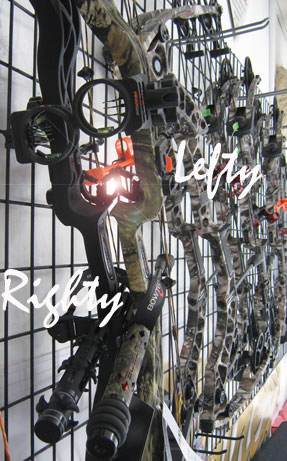
* Bow Square
* Bow string and bow cable
* Bow set-up measurements
* Allen keys
* Leatherman
* Portable Bowpress
I’ve had two bow string failures while hunting and both were 100% my fault. The first happened when I guess I was twelve or thirteen. I’d just sorted a feral cat and I laid my bow down. Problem was I just happened to lay it down on a sharp piece of glass that then cut my bowstring clean through. The second time, much older, I was rounding a hill and I slipped. My bowstring grazed a sharp granite rock as I went down and that severed half the strands. That finished my hunt. If this sort of thing happened to you – if your bow string is damaged when you are out hunting the wilds – do you have a Plan B?
Every “off the map” location you visit to bowhunt will pose its own unique limitations on what sort of kit you can take with you to sort out a bow failure. If you can take a 2nd bow on a trip of a life time, do so. Luggage restrictions on plane flights are getting tighter. But once in a life time trips don’t come cheap either. I’ve been on some small planes where it’s a battle to get your bow on board at all, let alone two. And you can forget bringing your antlers back on the return trip too – ship them separately. Some outfitters have an experienced guy with a good bow repair kit in the hunting camp – so ask when you book, that might save you bringing your own. If you decide that bringing your own kit is the way to go, make sure you test-drive your repair equipment. This way you’ll make any necessary improvements and additions specific to your bow before it’s too late.
You’ll need a sort of first aid kit for your bow if you are going to be able to change your bow string or bow cable when you’re away on an extended hunt…
BOW SQUARE – you need one of these in your kit to return your bow back to it’s set-up measurements. You’ll use it to double check the D-loop, peep and tiller (top and bottom limb to bowstring distance) are correctly positioned. Tiller is the big one if you have to back off the limb bolts to use the bow press. Without an accurate bow scale you’ll only be guessing your original poundage by drawing the bow back to ‘feel’ if it’s right. By winding your limbs all the way down until they bottom out against the riser, you’ll get them back in equal tiller to the bow string. Then back each limb the same number of turns until you get your correct tiller measurement. The D-loop and peep measurements are secondary as your spare bow string should ALREADY be good to go – shot in and set up correctly.
BOW STRING AND BOW CABLE – ideally they have both been on the bow and been well shot in. That is, setup with your peep and D-loop, shot through the bow tuning phase, waxed etc and then removed carefully and returned to the box they came in. If not, your bow set-up measurements will get you very close to where your bow was shooting originally. Having ALREADY installed your D-loop, the top and bottom serving that traps the peep and the bow cable serving that locates your drop away cord without the hassle of flies buzzing around you on hot day in camp or in poor light after a long day out hunting makes a lot of sense.
BOW SET-UP MEASUREMENTS – without these you won’t have a lot to work with to get your bow back to spec. Once your bow is shooting like a dream, write down these measurements and keep them with the rest of your bow first aid kit. Use the bow square to measure tiller. It’s the distance at 90deg to your bow string to where your top and bottom limbs emerge from the riser limb pockets. Measure the underside of your nocking point to the top axle and the distance of your peep to this axle as well. Use your measuring tape for this part as its likely to be the only thing in camp you’ll have to measure with. Record poundage too – you never know someone in a group hunt might have a bow scale.
ALLEN KEYS – without these you’re toast. Same with the LEATHERMAN – you might have to use your Leatherman pliers to pop off a circlip to fit a bow cable loop over an axle pulley.
PORTABLE BOW PRESS – I could break down my old High Country Excalibur and return it back to spec with an allen key and a bow square – no bow press needed. But today’s elite bows will not let you do this – you’ll need a bow press. Some bow models – especially the beyond parallel limb jobs need attachments that let the bow press do its thing. You also need to check your owners manual to know how much to back your limbs off. Mathews bows, for instance, specify ten full turns on each limb. The portable bow press does what an archery store bow press does – it exerts force on the limbs so the bow cable and strings go slack enough so you can mess with them. It’s just done on an agricultural level. The most important thing is they do what they do well and they might be just what you need one day to get your bow back into action.



